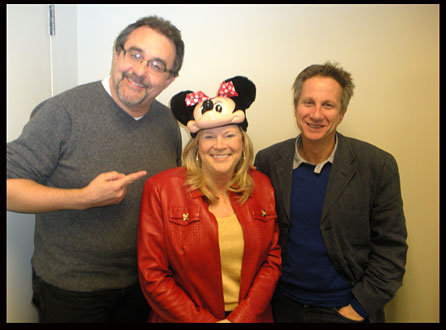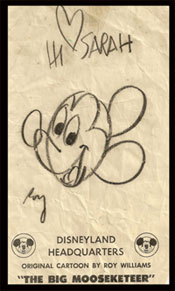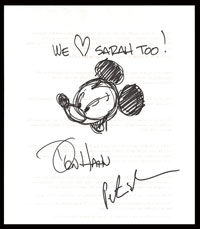
Sarah’s Backstage Pass Interviews Disney Film Legends:
Don Hahn: Animator, Producer, Director and Peter Schneider: Former President of Animation on Behalf of their New Film, Waking Sleeping Beauty
Backstage Notes: I must confess I have a close tie with Disney as it was very much a part of my childhood. I lived in California and more importantly near Disneyland growing up; attending the park many times with my family. As a child I looked forward to Walt Disney’s Sunday Night Movie and The Mickey Mouse Club every day after school. I thought Walt was the smartest and most creative man that had ever lived. As a result, I was very happy to continue nurturing the ‘Disney Magic’ to my own children.
After viewing the film “Waking Sleeping Beauty” I couldn’t help but feel a bit of nostalgia as those were the years I was raising my own family. The Beauty and The Beast, The Little Mermaid and The Lion King were very special to me and my daughter Kathrine. Meeting Don Hahn and Peter Schneider was a highlight in my life as I know these two men are responsible for bringing us Disney Magic and memories!
 Both men have a great sense of humor and we had a delightful morning.
Both men have a great sense of humor and we had a delightful morning.
Sarah Adamson: I’m speaking today with Disney Royalty!
Peter Schneider: Oh, they’ve left the room, you’re stuck with us. (Laughing)
SA: Congratulations on your upcoming documentary film, Waking Sleeping Beauty. I thoroughly enjoyed it!
Could you please tell our listeners what the movie is about?
Don Hahn: Thank you. It’s thrilling when people like our movie! Its about Disney animation in the 80s and 90s when there was an amazing perfect storm of people and circumstances that led to movies like, Who Framed Rodger Rabbit?, Beauty and the Beast, The Lion King, The Little Mermaid and Aladdin. And to Peter and I who lived through that era we thought well, it’s a story that’s been told often by outsiders but nobody really told it in a way that was in the trenches, at the tables, in the screening rooms and a behind the screen. That’s why we made this movie – is to take a look at the joy, the troubles, the debates, the happiness, the sadness and toll…and the costs of it all.
 Peter Schneider: At the same time, it’s not a puff piece like what you can see on DVDs about the making of these [movies] or how great we are. It’s a piece about why does art exist? Why did the group even come together over a ten-year period of time and do something that was remarkable? Our intention is that something remarkable happened and great art was produced among great trials and tribulations.
Peter Schneider: At the same time, it’s not a puff piece like what you can see on DVDs about the making of these [movies] or how great we are. It’s a piece about why does art exist? Why did the group even come together over a ten-year period of time and do something that was remarkable? Our intention is that something remarkable happened and great art was produced among great trials and tribulations.
SA: I can’t even begin to touch on the fascinating aspects of the film. First of all, I appreciated your brutal honesty in the film. You guys really tell it like it is.
DH: Well, it’s our story. We were there.
SA: Yes, but you didn’t ‘sugar coat’ it.
Don Hahn: Well, there was no reason to, really. That would be the easy way out – to say “Gee, weren’t we great? Didn’t we make great movies?” I think it was important to tell the human drama of it all. Life, in the arts particularly, is not a perfect life. So it was good to express that and to show that Disney is not a name that is devoid of personalities. Disney is actually human beings and people who have children and families and strive and have dynamics between them and that’s the story we wanted to tell. With words and all.
SA: Well, you certainly achieved that. I loved the actual footage you used in the film. Could you tell us a little bit about that?
 Peter Schneider: Well, that was Don’s idea, which was to not have a series of talking heads…that could tell the entire movie without archival footage. There was nothing that we used that was shot after 1994. We shot some footage of ourselves and decided that was a bad idea. We both have faces for radio (laughs). It was great to have our subjects being talked about and interviewed in terms of the modern interviews…but all the footage is from this period of time. We want to be at the table. We also didn’t want to put people in hair and makeup with bright lights and a camera and ask them about the past because they wouldn’t be as forthcoming as if we just sat down with a microphone and after a few minutes they forgot the microphone was there. They were very open about their experiences and that in combination with the archival footage makes you feel like you are right there in the room.
Peter Schneider: Well, that was Don’s idea, which was to not have a series of talking heads…that could tell the entire movie without archival footage. There was nothing that we used that was shot after 1994. We shot some footage of ourselves and decided that was a bad idea. We both have faces for radio (laughs). It was great to have our subjects being talked about and interviewed in terms of the modern interviews…but all the footage is from this period of time. We want to be at the table. We also didn’t want to put people in hair and makeup with bright lights and a camera and ask them about the past because they wouldn’t be as forthcoming as if we just sat down with a microphone and after a few minutes they forgot the microphone was there. They were very open about their experiences and that in combination with the archival footage makes you feel like you are right there in the room.
SA: I met former chairman, Dick Cook, last summer during The Christmas Carol tour. He was here [in Chicago] and I was thrilled to meet him! Could you tell our audience how he helped get this film made and his contributions to it?
PS: Dick was the chairmen of the studio and also the head of distribution during this time. Don and I went to Dick at the Hill Street Café in La Canyada, California. We bought him breakfast and said, “Dick we want to make this movie.” Without even thinking about it Dick said, “Absolutely, yes, let’s make this movie.” We didn’t even have to sell it. We made sure he understood that it was going to be a movie about people. That we were not always going to be as flattering about the film because some of us were not as flattering as we could be during the process. We wanted to make sure that it was going to be okay that we told our truth. It wasn’t going to be Disney’s truth or his truth or somebody else’s truth it was going to be Don’s and my truth of what happened during that period of time.
DH: And he was always supportive. We never got the feeling along the way that he was going to pull the plug on it. So supportive! He even helped us connect with Jeffrey Katzenberg and Paul Jeffrey. He was very open in terms of what we were trying to do in this moment of time we were trying to capture.
SA: Roy Disney’s role has always been somewhat of a mystery role, to me. I appreciated the fact that now I understand his contributions to Disney. He’s in the film quite a bit. Could you tell us about Roy?
DH: Well it doesn’t hurt to have the last name Disney (laughs) and to be the primary shareholder during this time but you wouldn’t know it by having Roy in the room. I think what made him interesting to us is that he wasn’t himself a filmmaker. He was an editor. He worked on a lot of the Disney major movies. He became, in a sense, our fairy godfather. He was an advocate for us in really crucial times and with new technologies that we needed. And yet, he would stay out of the way. He wouldn’t hover. He wouldn’t look over our shoulders. He was really that wonderful combination of a godfather character. He trusted us and trusted that we could make good movies.
PS: He was a protector. When Michael Eisner and Frank Wells came into the company Roy basically protected the animation division. It was doing no business. It wasn’t a financial power source. Roy’s attitude was to leave it alone, leave it to me. I’ll take care of it while you go off and solve of the problems of the parks and the live action consumer products. Leave all the animation alone. I may not know a lot about it but I know more about it than all you guys put together. And he was the godfather of it. He was the protector. He was the person that made sure it grew, that it was nourished and that it had all the resources that it needed.
SA: Thank you so much for talking about him. He really is such a special person.
PS: He just died in December of this year. It was really sad. He had been sick for a really long time. I was thrilled that Don was able to take the movie down and show it to him. He saw it about four times because it really was, as with all of us, an important part of our lives and part of his personal history so it was a little bit like watching home movies for Roy.
SA: I’d like to talk about another Roy that I met when I was ten years old, Roy Williams. I actually have a drawing that Roy drew for me of Mickey Mouse. I read that he was a wonderful person and actually a friend of Walt Disney’s.
DH: Yeah, he worked with Walt Disney and worked in the story department at Disney. We all know him from television and he was the big Mouseketeer on the Mouse Club Show. Before that though, he worked in the story department and he came up with so many of the clever ideas and gags and things that went into so many of the early Disney movies.
SA: I know he really enjoyed that.
DH: Yeah, he was famous for turning out sketches for kids that ended up inspiring them. And you have one right in front of you. That’s so cool.
SA: Yes, and I treasure it!
PS: You have these drawings from when you were ten years old. Its overwhelming sitting here with these memorabilia because the Disney Company, the movies, what Disney means in peoples lives cannot be underestimated. That part of the movies, the TV shows, these animated movies that Roy, Don and I made together really are an emotional part of people’s lives and sometimes we get jaded. Sometimes we forget about it. And in regards to this movie – the reaction to it is, “oh my gosh, these are the movies that changed my life. I never knew all this was going on in the making of them.” These movies are so emotional and therefore the movie, Waking Sleeping Beauty is emotional.
DH: Last night we showed it in Chicago and a college student came up to us and said, “I had these sheets, I wore that dress and I grew up with those songs.” We don’t think of it in those terms. We think of it as we had a great experience making movies but the truth of it is we’re the luckiest guys on the planet. We had a really special time with hundreds of collaborators that are not at this table right now that really did some special things and this movie tries to capture that. It tries to capture some of the joy that goes into the making of all these movies.
SA: Absolutely, and I think that’s what the viewers are going to find with this film. At the screening I viewed it with a publicist that was 21 years old and we talked about it afterwards. I said this is what is so cool with this film – it’s going to be so cross generational and it will generate a lot of discussion about this neat period of time.
DH: I hope so. And we still see echoes from this period time. We still see in the animation business now that 15-20 animated films are nominated or at least considered for best-animated film at the Oscars. You see a whole generation of kids in their twenties now who grew up in musical theatre. And when has that happened in recent history?
SA: I loved the caricatures too between the different segments.
DH: Well I think one of the ways artists’ vent is through their pencils. There are some skating caricatures – a caricature would be a cartoon that exaggerates reality on the page. Peter, I think we caricature you extensively in the film (laughs). April fools day we still have a caricature show so that every artist gets to make fun of whoever they want by drawing them in a funny, awkward, embarrassing, and unflattering pose. Then, think of the most off-putting characteristic and exaggerating it beyond belief. It’s not a pleasant exercise but it still is funny. I think we want to show that kind of culture in an animation studio. I mean for God sake, it’s an animation studio! People have rubber band fights and throw food around. There is no reason to take it all that seriously and I think by putting in caricatures and drawings from that era it shows a bit of the fun that takes place. Some of the more scathing ones, we couldn’t use because they are saucy (laughs).
SA: Is there anything else you’d like to say to our audience?
DH: Go see the movie March 26th! It was a real joy for us to make. I think the most wonderful screening we’ve had was the cast and crew screening. We invited everybody in the movie who worked on all these movies like Beauty and the Beast and Aladdin to come to the El Capitan Theatre. We had 1,000 people that night. It was like the biggest class reunion you’ve ever seen. It was a very emotional event for all of us. With twenty years distance you realize, well, we didn’t know it at the time, but we made some movies that have ended up in the popular culture…and that we have in some small way made a tiny dent in the universe. That’s something that is really amazing and special and of course, you just don’t realize it when you’re working on it. I mean, nobody wanted to work on The Lion King. It was the biggest loser of an idea. It was Moses meets Joseph and Hamlet with music by Elton John…who wants to work on that? When you look at it with some retrospective – with some years behind you, you go – you know we were really lucky, really naive and stupid in many ways. We fell luckily into some things and other things by our own cleverness. But it was a great time and a perfect storm of all these people that came together to make those movies and to make that time special and that is what we try to capture in the movie.
SA: Thank you so much for chatting with me today. Waking Sleeping Beauty is certainly a rare gem of a film that everyone can enjoy!
Sarah Adamson © February 4, 2010
